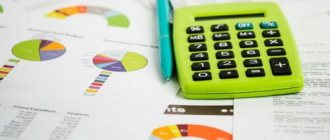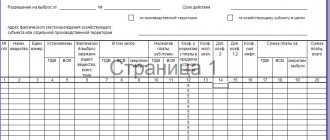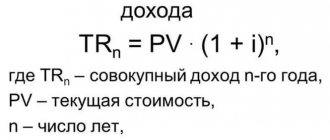What is gross profit?
Gross profit is the difference between income and cost. Taxes are not deducted from these funds. Cost means:
- costs of producing the product: costs of materials, equipment maintenance;
- expenses for purchasing a finished product at the purchase price;
- payment for electricity;
- salary payments.
How is net profit distributed among LLC participants ?
All these indicators constitute technical costs.
IMPORTANT! VP is calculated for a specific period. The time period depends on the company. The resulting figure is indicated in the balance sheet.
Ledger
Why is it needed?
Reference! Maintaining a book is a mandatory requirement of the Ministry of Taxes and Taxes of the Russian Federation. The size of the book depends on the volume of activity. In large enterprises it consists of several parts.
The book of accounting for gross proceeds from the sale of goods, works, and services is a mandatory document for the general taxation system. The book records all income and expenses received as a result of your business activities. The document records all transactions performed.
All necessary information about the taxpayer is recorded on the title page of the accounting book.:
- Full name of the entrepreneur.
- TIN.
- Taxable enterprise.
- Unit measurements.
- Residence address of the individual entrepreneur.
- Bank account numbers.
- Name of the bank.
Before you begin maintaining documentation, you must number each page. On the last sheet the number of pages is recorded, confirmed by a stamp and signature.
Nuances
A document is filled out taking into account all income, expenses and other business transactions, i.e. based on primary documentation. All transactions and expenses for the activities carried out are indicated in the book of accounting for expenses and revenues. When maintaining a book, the following points are taken into account:
- Currency in which accounting is carried out . A mandatory condition is keeping records in rubles, even for entries that were made in foreign currency. These transactions are also recorded in Russian payment units. In such cases, the amount is determined by converting the currency at the Central Bank exchange rate on the day the income is received (you will find out how the repatriation of foreign currency earnings occurs here).
- Recording all transactions . It must be done in Russian. If the document was drawn up in a foreign language, it is necessary to translate each individual line into Russian. During the registration of records, each type of transaction maintains its own records.
- Electronic book for accounting of explosives . Today, entrepreneurs are increasingly trying to use electronic versions of the accounting book. This method of maintaining a document is much more convenient and functional, but in the end, the book still needs to be printed. The same procedures are carried out for it: page numbering, stitching sheets, indicating the number of pages on the last sheet.
- Editing entries . If an error is made while maintaining the accounting book, they must be corrected and certified by the owner. When maintaining an e-book, in order to correct an error, you should replace the incorrect data and put a “minus” mark. In the paper version, the error is crossed out, and the correct data is entered next to it, which is certified by the owner.
The gross revenue accounting book is certified by the Federal Tax Service (where you can also get a sample of how to fill it out). The Tax Code of the Russian Federation does not indicate the deadlines required for submitting the book and, in connection with this, individual entrepreneurs certify the book along with the tax return.
Important! If there is no accounting book, a fine will be imposed on the entrepreneur.
The book can be filled out by both the entrepreneur and his accountant (or authorized representative). The gross receipts ledger is kept for 5 years. If there is no business activity during the reporting period, maintaining a book is not mandatory.
What influences VP?
Gross profit changes under the influence of external circumstances, such as:
- cost of transportation services,
- natural, environmental factors,
- socio-economic environment in which the enterprise operates,
- costs of production resources,
- foreign economic contacts.
What affects the amount of retained earnings (uncovered loss) ?
VP is also influenced by internal factors:
- income from product sales,
- other sources of income: investments, provision of services,
- cost of goods,
- demand for manufactured products, sales figures,
- cost of manufactured goods.
Gross profit is also affected by negative factors possible during the operation of the enterprise:
- overestimated or underestimated cost of products sold;
- low quality of goods;
- disciplinary violations by the company’s employees leading to losses;
- fines and sanctions.
The listed factors can affect the gross profit directly and indirectly. Factors that affect sales income have an indirect influence.
Gross profit composition
The VP may include the following financial resources:
- profit from sales of enterprise products and services;
- funds received from rural and logging farms;
- income from the sale of company property: equipment and other objects;
- amounts received from transactions not included in the main list of company activities. For example, a store sells goods. This is his main activity. However, the funds are spent on investments, the income from which is classified as non-operating profit;
- amounts received from the sale of shares.
The vast majority of EP, according to statistics, consists of income received from core activities.
Gross profit, EBIT and EBITDA - what do they have in common?
When analyzing the financial condition and economic activities of an organization, EBIT and EBITDA indicators are used in world practice. In the Russian Federation they are used mainly by the largest resource extraction companies (Lukoil, Gazprom, etc.). Among domestic small and medium-sized businesses, these indicators have not received much widespread and practical application.
Their difference from gross profit lies in the special “cleaning” of this indicator and the calculation algorithm.
EBIT and EBITDA are determined in Russia somewhat differently than under IFRS. In domestic practice, EBIT and gross profit are identical. EBIT is the difference between sales revenue and direct expenses. In the Russian Federation, when calculating it, one must take into account the amount of net interest, income tax reimbursement and the balance of extraordinary expenses and income.
- EBITDA = EBIT + depreciation.
Formula for calculating gross profit
Gross profit is calculated using the formula:
VP = D - (S+W)
The formula includes the following indicators:
- VP – gross profit;
- D – quantity of products sold;
- C – cost of production of goods;
- C – costs of production processes.
VP indicators can be calculated after the product has been produced and sold.
ATTENTION! Typically, gross profit is calculated once a year.
Example
The company produces electric kettles. Production costs are 20,000 rubles, expenses are 10,000 rubles. 500 teapots were sold per day at a cost of 1000 rubles.
Calculations are carried out as follows: revenue per day is calculated. That is, the number of teapots sold is multiplied by their cost. We will receive 500,000 rubles. From this result you need to subtract all costs, which in total amount to 30,000 rubles. From 500,000, 30,000 rubles are deducted. Gross profit will be 470,000 rubles.
Calculation features
The calculation of VP differs in a number of nuances, determined by the type of activity of the enterprise:
- If a company specializes in selling products, it is required to deduct all expenses from revenue, including discounts on goods and returns. The cost of production is subtracted from the amount received. The result of the calculations is the gross profit;
- If an organization specializes in providing services, calculations are usually carried out according to a simplified scheme. Their revenues are deducted from discounts and other expenses. The resulting net profit is also gross profit.
The main stages of the calculation are standard.
Why is gross cost calculation necessary?
Gross profit does not reflect the actual income of a business. This figure includes many unnecessary expenses: advertising, salaries, rent. VP is required for other purposes. This is a narrow, not a general tool. It is used to analyze the production resources of an enterprise. Correctly calculated indicators ensure the achievement of the following goals:
- analysis of the difference between the cost of a product and the income from its sale;
- determining the optimal cost for a product or service;
- competent measures for planning the company’s activities;
- identifying problems and weaknesses of the enterprise.
Based on the analysis of annual VP indicators, it is possible to track the economic growth of the enterprise and the results of optimizing activities.
The essence of gross output in the agro-industrial complex system.
The gross output of the agro-industrial complex represents the value of the total product created as a result of the production of agricultural raw materials, its processing and bringing it to its final consumer form. In the agricultural sector of the agro-industrial complex under gross output
refers to the cost of products obtained as a result of growing plants, animals and their economic use for a certain period of time (day, month, quarter, season, calendar year, etc.).
The value of gross agricultural output consists of:
1.the cost of means of production consumed in the production process during a given period (year)
, that is, from the value transferred to the product, created by past labor (the cost of material production costs, that is, the cost of seeds, feed, fuel and other material resources spent in the production process);
2.newly created value by the labor of workers during a given period (year), or net agricultural products
.
Gross agricultural output consists of gross output of crop production and livestock production.
Gross crop production includes:
1. cost of gross harvest of agricultural crops;
2. the cost of growing perennial crops for agricultural purposes;
3. the cost of the increase in work in progress (usually winter crops) from the beginning to the end of the year.
Gross livestock production includes the cost of animal rearing products, i.e. offspring, growth and weight gain of live weight, as well as products obtained from the economic use of animals (milk, wool, eggs, etc.).
The volume of agricultural production can be determined for a calendar, agricultural year and other periods. For this, two indicators are used:
1. gross output determined using the gross turnover method
, i.e., as a simple sum of raw crop and livestock products (characterizes the size of agricultural production);
2. gross output without recounting or final output
(more accurately reflects the volume of products produced that can be used for non-productive consumption and accumulation within the enterprise and outside it).
The final agricultural product is calculated by subtracting from the gross output the cost of crop and livestock products consumed in the process of agricultural production in a given year.
The value of gross agricultural output is divided into:
1. the cost of material production costs, i.e.
How to increase gross profit?
Gross profit is a dynamic indicator. It constantly changes depending on the company's activities. The following activities help increase VP:
- use of LIFO technique in inventory analysis;
- tax reduction with the help of benefits that the enterprise is entitled to;
- regular write-off of bad debts from the balance sheet;
- optimization of production processes aimed at reducing costs;
- competent pricing policy that takes into account the demand for products and the general market situation;
- improving the quality of equipment to speed up the release of goods and improve their quality. Restoration or acquisition of equipment can be carried out at the expense of shareholder dividends;
- creation of reasonable standards to ensure control over intangible assets.
IMPORTANT! Gross profit is an indicator on the basis of which planning of an enterprise’s activities in the production sector can be carried out.
So. Gross profit is the amount obtained after deducting costs and production costs.
Determined by formula. The nuances of the calculation depend on the type of activity of the enterprise. The VP indicator is important for assessing the company's production resources. Is the basis for reasonable pricing. Gross profit is reflected in the financial statements using the appropriate entries established by the Order of the Ministry of Finance.









